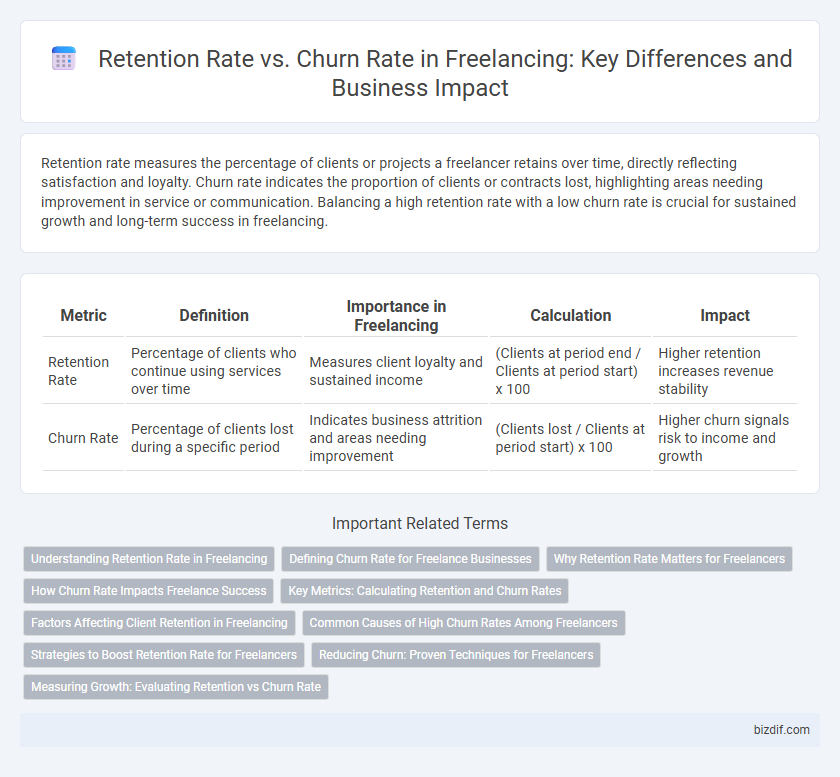Retention rate measures the percentage of clients or projects a freelancer retains over time, directly reflecting satisfaction and loyalty. Churn rate indicates the proportion of clients or contracts lost, highlighting areas needing improvement in service or communication. Balancing a high retention rate with a low churn rate is crucial for sustained growth and long-term success in freelancing.
Table of Comparison
| Metric | Definition | Importance in Freelancing | Calculation | Impact |
|---|---|---|---|---|
| Retention Rate | Percentage of clients who continue using services over time | Measures client loyalty and sustained income | (Clients at period end / Clients at period start) x 100 | Higher retention increases revenue stability |
| Churn Rate | Percentage of clients lost during a specific period | Indicates business attrition and areas needing improvement | (Clients lost / Clients at period start) x 100 | Higher churn signals risk to income and growth |
Understanding Retention Rate in Freelancing
Retention rate in freelancing measures the percentage of clients who continue to hire a freelancer over a specific period, serving as a key indicator of client satisfaction and long-term business stability. High retention rates reflect strong freelancer-client relationships, consistent quality of work, and effective communication, which contribute to sustained income and reputation growth. Tracking this metric helps freelancers identify successful strategies and areas needing improvement to minimize churn rate and maximize recurring revenue.
Defining Churn Rate for Freelance Businesses
Churn rate in freelance businesses measures the percentage of clients lost over a specific period, directly impacting revenue stability and growth potential. Tracking churn rate helps freelancers identify client retention challenges and optimize service strategies to maintain long-term relationships. A low churn rate is crucial for sustaining consistent income and building a reliable freelance brand.
Why Retention Rate Matters for Freelancers
Retention rate directly impacts a freelancer's income stability and client trust, as consistently satisfied clients lead to recurring projects and referrals. High retention reduces marketing expenses and time spent acquiring new clients, allowing freelancers to focus on enhancing skills and quality. Maintaining a strong retention rate signals professionalism and reliability, essential factors for building a robust freelance career.
How Churn Rate Impacts Freelance Success
Churn rate directly affects freelance success by indicating the percentage of clients lost over a given period, which impacts income stability and project continuity. High churn rates signal dissatisfaction or competition challenges, reducing repeat business and consistent referrals. Maintaining a low churn rate enhances client retention, boosts reputation, and contributes to sustainable freelance growth.
Key Metrics: Calculating Retention and Churn Rates
Retention rate measures the percentage of clients who continue using freelance services over a specified period, while churn rate indicates the proportion of clients lost. Calculating retention involves dividing the number of clients retained by the total clients at the start of the period, multiplied by 100 to get a percentage. Churn rate is calculated by dividing the number of clients lost by the total clients at the start, also expressed as a percentage, providing critical insights into freelancing business stability.
Factors Affecting Client Retention in Freelancing
Client retention in freelancing is heavily influenced by consistent communication, quality of deliverables, and adherence to deadlines. Building trust through transparent project updates and responsiveness reduces churn rate significantly. Offering value-added services and personalized solutions enhances client satisfaction, directly improving retention rate.
Common Causes of High Churn Rates Among Freelancers
High churn rates among freelancers often stem from inconsistent project flow, lack of client engagement, and insufficient communication channels. Financial instability drives many freelancers to seek more reliable income sources, resulting in frequent client turnover. Poor project management and unclear expectations further exacerbate churn, reducing overall freelancer retention rates.
Strategies to Boost Retention Rate for Freelancers
Freelancers can boost retention rates by consistently delivering high-quality work and maintaining clear communication with clients. Implementing personalized follow-ups and offering loyalty incentives fosters long-term client relationships, reducing churn rate effectively. Utilizing project management tools ensures timely delivery and client satisfaction, further enhancing retention in competitive freelancing markets.
Reducing Churn: Proven Techniques for Freelancers
Reducing churn rate is essential for freelancers aiming to maintain a stable client base and increase long-term revenue. Effective techniques include delivering consistent high-quality work, establishing clear communication channels, and setting realistic expectations to build trust and satisfaction. Utilizing feedback loops and offering value-added services further enhance client retention and minimize churn.
Measuring Growth: Evaluating Retention vs Churn Rate
Retention rate measures the percentage of freelancers or clients who continue using a platform over a specific period, indicating loyalty and satisfaction. Churn rate quantifies the percentage of users who leave or stop engagements, reflecting potential issues or market competition. Evaluating both rates provides a clear metric for freelancing growth by balancing user acquisition with sustained engagement and identifying areas needing improvement.
Retention Rate vs Churn Rate Infographic

 bizdif.com
bizdif.com